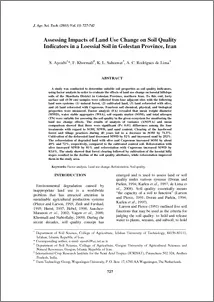Assessing Impacts of Land Use Change on Soil Quality Indicators in a Loessial Soil in Golestan Province, Iran

Abstract
A study was conducted to determine suitable soil properties as soil quality indicators, using factor analysis in order to evaluate the effects of land use change on loessial hillslope soils of the Shastkola District in Golestan Province, northern Iran. To this end, forty surface soil (0-30 cm) samples were collected from four adjacent sites with the following land uses systems: (1) natural forest, (2) cultivated land, (3) land reforested with olive, and (4) land reforested with Cupressus. Fourteen soil chemical, physical, and biological properties were measured. Factor analysis (FA) revealed that mean weight diameter (MWD), water stable aggregates (WSA), soil organic matter (SOM), and total nitrogen (TN) were suitable for assessing the soil quality in the given ecosystem for monitoring the land use change effects. The results of analysis of variance (ANOVA) and mean comparison showed that there were significant (P< 0.01) differences among the four treatments with regard to SOM, MWD, and sand content. Clearing of the hardwood forest and tillage practices during 40 years led to a decrease in SOM by 71.5%. Cultivation of the deforested land decreased MWD by 52% and increased sand by 252%. The reforestation of degraded land with olive and Cupressus increased SOM by about 49% and 72%, respectively, compared to the cultivated control soil. Reforestation with olive increased MWD by 81% and reforestation with Cupressus increased MWD by 83.6%. The study showed that forest clearing followed by cultivation of the loessial hilly slopes resulted in the decline of the soil quality attributes, while reforestation improved them in the study area
